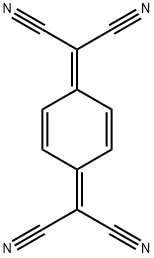7,7,8,8-Tetracyanoquinodimethane
Synonym(s):(2,5-Cyclohexadiene-1,4-diylidene)-dimalononitrile;TCNQ;TCNQ, 1,4-Bis(dicyanomethylene)-2,5-cyclohexadiene
- CAS NO.:1518-16-7
- Empirical Formula: C12H4N4
- Molecular Weight: 204.19
- MDL number: MFCD00011664
- EINECS: 216-174-8
- SAFETY DATA SHEET (SDS)
- Update Date: 2024-12-18 14:08:57

What is 7,7,8,8-Tetracyanoquinodimethane?
Description
7,7,8,8-tetracyanoquinodimethane (TCNQ), with a LUMO at 4.5 eV, is known for the charge-transfer salts formed by its radical anion TCNQ in?photovoltaic, light-emitting diodes, and organic field-effect transistor?devices. TCNQ and its derivatives?have been used as dopants, leading to an increase in hole mobility or to the lowering of injection?barriers. One classic example of such is the treatment of tetrathiafulvene (TTF), an electron donor with TCNQ. TFF and TCNQ form an ion pair, the TTF-TCNQ complex. This process of doping leads to the crystallisation of the ion pair into a one-dimensionally stacked polymer. This polymer consists of segregated stacks of cations and anions of the donors and the acceptors, respectively. The complex crystal is an organic semiconductor that exhibits metallic electric conductivity [1, 2].
Chemical properties
orange to green crystalline powder
The Uses of 7,7,8,8-Tetracyanoquinodimethane
7,7,8,8-Tetracyanoquinodimethane is an electron-acceptor molecule used to form charge-transfer superconductors. It is an effective catalyst used for the ?-chlorination of carboxylic acids using chlorosulfonic acid; the presence of TCNQ suppresses competing free-radical chlorination.
What are the applications of Application
7,7,8,8-Tetracyanoquinodimethane is A biochemical involved in the formation of charge-transfer complexes
Definition
ChEBI: A quinodimethane that is p-quinodimethane in which the methylidene hydrogens are replaced by cyano groups.
Synthesis Reference(s)
Journal of the American Chemical Society, 84, p. 3370, 1962 DOI: 10.1021/ja00876a028
The Journal of Organic Chemistry, 48, p. 1366, 1983 DOI: 10.1021/jo00156a048
General Description
7,7,8,8-Tetracyanoquinodimethane (TNCQ) is a strong electron acceptor as it has four cyano groups and π-conjugation bonds that form charge transferring chains and ion radical salts which are mainly used as p-dopants for the fabrication of a variety of semiconductor applications.
Properties of 7,7,8,8-Tetracyanoquinodimethane
| Melting point: | 287-289 °C (dec.) (lit.) |
| Boiling point: | 332.67°C (rough estimate) |
| Density | 1.3596 (rough estimate) |
| refractive index | 1.5000 (estimate) |
| storage temp. | Sealed in dry,Room Temperature |
| form | Crystalline Powder |
| color | Orange-brown to green |
| Water Solubility | insoluble |
| λmax | 395nm(CH3CN)(lit.) |
| BRN | 611604 |
| Stability: | Stable. Incompatible with strong acids, strong bases, strong reducing agents, strong oxidizing agents. |
| CAS DataBase Reference | 1518-16-7(CAS DataBase Reference) |
| NIST Chemistry Reference | Propanedinitrile, 2,2'-(2,5-cyclohexadiene-1,4-diylidene)bis-(1518-16-7) |
| EPA Substance Registry System | Propanedinitrile, 2,2'-(2,5-cyclohexadiene-1,4-diylidene)bis- (1518-16-7) |
Safety information for 7,7,8,8-Tetracyanoquinodimethane
| Signal word | Danger |
| Pictogram(s) |
 Skull and Crossbones Acute Toxicity GHS06 |
| Precautionary Statement Codes |
P280:Wear protective gloves/protective clothing/eye protection/face protection. |
Computed Descriptors for 7,7,8,8-Tetracyanoquinodimethane
New Products
4-Fluorophenylacetic acid 4-Methylphenylacetic acid N-Boc-D-alaninol N-BOC-D/L-ALANINOL Tert-butyl bis(2-chloroethyl)carbamate 3-Morpholino-1-(4-nitrophenyl)-5,6-dihydropyridin- 2(1H)-one Furan-2,5-Dicarboxylic Acid Tropic acid S-2-CHLORO PROPIONIC ACID ETHYL ISOCYANOACETATE 2-Bromo-1,3-Bis(Dimethylamino)Trimethinium Hexafluorophosphate (6-METHYL-[1,3]DITHIOLO[4,5-b]QUINOXALIN-2-ONE INDAZOLE-3-CARBOXYLIC ACID 4-IODO BENZOIC ACID (2-Hydroxyphenyl)acetonitrile 4-Bromopyrazole 5,6-Dimethoxyindanone 2-(Cyanocyclohexyl)acetic acid 4-methoxy-3,5-dinitropyridine 2-aminopropyl benzoate hydrochloride 1-(4-(aminomethyl)benzyl)urea hydrochloride diethyl 2-(2-((tertbutoxycarbonyl)amino) ethyl)malonate tert-butyl 4- (ureidomethyl)benzylcarbamate Ethyl-2-chloro((4-methoxyphenyl)hydrazono)acetateRelated products of tetrahydrofuran








You may like
-
 7,7,8,8-Tetracyanoquinodimethane, 98% CAS 1518-16-7View Details
7,7,8,8-Tetracyanoquinodimethane, 98% CAS 1518-16-7View Details
1518-16-7 -
 7,7,8,8-Tetracyanoquinodimethane (purified by sublimation) CAS 1518-16-7View Details
7,7,8,8-Tetracyanoquinodimethane (purified by sublimation) CAS 1518-16-7View Details
1518-16-7 -
 7,7,8,8-Tetracyanoquinodimethane, 98% CAS 1518-16-7View Details
7,7,8,8-Tetracyanoquinodimethane, 98% CAS 1518-16-7View Details
1518-16-7 -
 7,7,8,8-Tetracyanoquinodimethane CAS 1518-16-7View Details
7,7,8,8-Tetracyanoquinodimethane CAS 1518-16-7View Details
1518-16-7 -
 7,7,8,8-Tetracyanoquinodimethane CAS 1518-16-7View Details
7,7,8,8-Tetracyanoquinodimethane CAS 1518-16-7View Details
1518-16-7 -
 1975-50-4 98%View Details
1975-50-4 98%View Details
1975-50-4 -
 14714-50-2 (2-Hydroxyphenyl)acetonitrile 98+View Details
14714-50-2 (2-Hydroxyphenyl)acetonitrile 98+View Details
14714-50-2 -
 118753-70-1 98+View Details
118753-70-1 98+View Details
118753-70-1